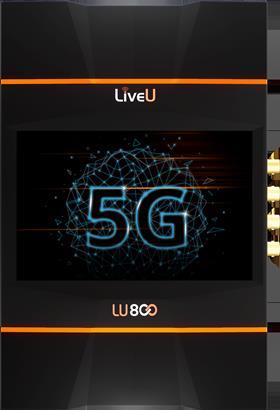Figuring out the optimal configuration of 5G for mobile broadcast is a current preoccupation of the broadcast industry. Key learnings are expected from an EU-funded project that involves the participation of tech outfit LiveU.
While the use of 5G to deliver coverage of live events is now well established, the technologies required to support it are still evolving.

Live broadcast technology specialist LiveU recently won an open call to test future technologies as part of the FIDAL Large Scale Field Trials Beyond 5G project. This is an EU Horizon Europe-funded research and innovation programme covering smart networks and services. LiveU is to contribute to the FIDAL/B5VideoNet4 (B5GVN) project to test use cases covering remote and cloud-based production along with edge computing, private networks and network exposure.
The 5G test bed on which LiveU is working is based in Greece, with participants including the University of Patras; telco Nova, which is providing spectrum for the tests; The Foundation for Research and Technology – Hellas (FORTH); and network exposure capacity provider Ubitech.
5G capabilities
LiveU transmits video from coverage of events and uses software receivers hosted in a public cloud such as AWS or at the broadcaster’s facility. For the B5GVN project, it is deploying its Multimedia Hub (MMH) as a standard Kubernetes pod, installed at the edge within the 5G network.
Baruch Altman, LiveU’s AVP, Head of 5G Projects and ESG, says that the project will test different 5G capabilities including network slicing – providing guaranteed bandwidth for certain applications – edge computing, network exposure and private networks.
LiveU is a remote production and outdoor production specialist. In the case of 5G, connectivity is required to transmit content from the 5G uplink in LiveU’s units for downlink to the production team, which may itself be located in the field.
“If you have several cameras in the field – and some of them might be at the same location – they all uplink via a LiveU bonded encoder [and] via the same private network in the downlink to the production team in the field, using what we call an Xtend, which is a bonding device for the downlink,” says Altman.
In this way, says Altman, bottlenecks in the downlink are avoided, giving the producer and director a clear view of incoming streams that can then be uploaded to the cloud.
Another use case, he says, is to place LiveU receivers within the network at the edge that can be connected to other applications at the operator edge such as for streaming to users.
Bonded encoders combine spectrum from multiple networks to create a single connection with added capacity. Bonding is key to the use of 5G, according to Altman.
“You need bonding because even slices don’t provide guaranteed bandwidth – it’s never really guaranteed,” says Altman. “Even over a private network it’s never guaranteed. There are fluctuations in the bandwidth and in the latency, and sometimes losses. So, the bonding of multiple networks even on the same private network is critical to create this reliability and high quality for live video. We’re seeing in the tests of all use cases, that bonding is required both for the uplink and for the downlink to the mobile receiver with the producer in the field.”
Altman says that LiveU is “playing with various types of slices” in close partnership with Ubitech. Specifically, he says, the company is testing how much bandwidth is guaranteed and what the radio parameters are, among other things.
“We believe the use of commercial slicing that’s currently in the market is at an early stage and very focused on specific use cases. Operators say they will offer slices for this or that use case in this area, so it’s not large-scale, not yet flexible and not widely commercially available,” he says.
Suitable configuration
Part of the objective of the B5GVN project is to figure out the setup and configuration that is most suitable for LiveU’s type of user to produce live video in the field. “That’s quite unique and the results that we’re getting are very interesting in terms of what could be expected versus the actual outcome. But these are preliminary results, and we’ll have another half year to complete the testing,” says Altman.
While the tests being carried out by LiveU will help define what adaptations are required to its algorithms, they will not determine what makes a compelling business case for the mobile operators to offer slicing commercially. This commercial element will be critical for any future development of slicing as a viable proposition. What is clear is that LiveU’s media customers would like guaranteed bandwidth.
“Bonding is definitely part of that, but bonding would also benefit from slicing with guaranteed bandwidth,” says Altman. “So there’s a commercial aspect, and also a regulatory aspect in some countries… but there’s also the technical part and there I think flexibility is critical, because if the operators dictate what they have and how many users are going to be allowed on specific slices and so forth, that may fit or it may not.”
This could be important not only for broadcast but for adjacent applications such as public safety announcements, he says.
In relation to private networks, for the B5GVN tests, LiveU is working with spectrum that Altman says is “not completely private” in that it has been reallocated from other uses. While LiveU can change or reconfigure certain things in the core of the network, Altman says that the investment required to implement a service would likely be limited – with the disclaimer that not everything required to set up such a network is being tested here.
LiveU is also testing the ability to order and configure the private network remotely – the network exposure element of the project.
Network exposure – meaning APIs – allow the company to service the network. “If there is a future event and a customer wants guaranteed bandwidth and to use our receiver, they can use our customer portal and order this receiver along with resources such as [network] slices and this will be set up via standard APIs,” says Altman.
Network exposure
Network exposure is based around the use of standard APIs that also allow providers – for example – to ensure that networks used for broadcast applications are secure by authenticating SIMs to detect fraud.

In the case of the B5GVN project, LiveU is developing the ability, as an example, to order specific network resources in a specific area at a specific time – something Altman says has not been done before – using standard TM Forum APIs.
Other aspects of 5G broadcast being examined include looking at conditions where there is likely to be network congestion, and how much capacity is needed for different use cases.
Altman does not believe the technologies needed to ensure 5G works to enable broadcast applications will ever become mandatory elements of the 3GPP standard but may emerge as options or guidelines for 5G.
The project involves the transmission of eight full HD video streams from the same location, encoded in HEVC from LU800 PRO multi-camera field units. “We’re placing several of these together at the same location, which creates quite a load and simulates whatever the real use case is,” says Altman, adding that the project aims to test continuity of transmission rather than consistent video quality devoid of artefacts.
The overall set of goals, he says, includes learning more about how guaranteed bandwidth and network slices behave, how links behave on these networks in various conditions with different levels of congestion, and what it takes to implement LiveU’s Kubernetes MMH port at the edge.
The overall FIDAL programme has a duration of about three years (it is currently about mid-way through). For LiveU, the tests being conducted as part of B5GVN are for 12 months and are due to be completed in May next year.
























No comments yet